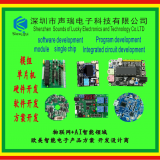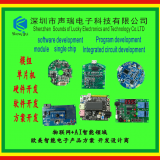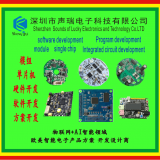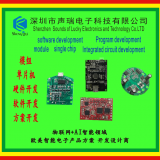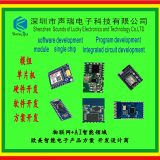Singlechip Bluetooth Module Voice Module Hardware Development
Seven kinds of sensor devices for different object detection
Object detection is a very important task in the automation industry, it is to detect whether there is an object passing through the conveyor belt, whether the door is closed, whether the vehicle has reached the stop position. Industrial control engineers and software developers need to know reliably when an object or target arrives or is placed in a specific location.
Although sensing devices cannot measure, check or quantify objects in any way, they must reliably transmit the existence of objects to the control system of machines through electronic signals. There are many different object sensing technologies for different object detection. The seven most common types are discussed below, along with a brief description of their operation, advantages, and limitations.
1. Electromechanical.
The most basic sensor is the electromechanical limit switch. These devices contain a sensitive microswitch. When a mechanical drive is replaced by a detected object, its state changes. Rollers, tentacles, and levers are versions of actuators from many different manufacturers. Because these devices are made up of moving parts, they are easy to wear and damage. In addition, physical contact with the target object is not always desirable or possible.
2. Pneumatic.
These sensors use compressed air and a sensitive diaphragm valve to detect the presence of objects. Compressed air flows out of a tiny hole until it is blocked by the target, causing a slight change in air pressure. The downstream diaphragm switch detects this pressure change and generates an electrical control signal. Environments requiring "explosion-proof" sensors or very dirty environments are good applications for this device.
3. Magnetism.
The magnetic sensor is driven by a permanent magnet in the sensing range. Generally, two different working principles are adopted, one is reed contact, the other is Hall effect sensor. In both cases, the presence of a magnetic field changes the state of the electrical signal. Reed and Hall effect sensors are usually used to detect the presence of pistons in cylinders. Reed switches have a high failure rate, so many engineers specify Hall effect sensors where possible.
4. Induction.
Inductive proximity sensors - these proximity switches detect metal objects, which can damage the electromagnetic field emitted by the sensor body. The reliable detection distance depends on the type and amount of metal in the sensor range. These sensors come in many sizes and shapes. They are very reliable and cost-effective; therefore, a large proportion of sensors are used in automation and process equipment.
5. Capacitance.
These proximity switches can detect nonmetallic objects with different dielectric constants in the air. This makes them ideal materials for wood, paper, fabrics, liquids and plastics. They work like inductive sensors, but instead of detecting changes in electromagnetic fields, they use electrostatic fields.
6. Photoelectricity.
Photoelectric sensors use different technologies to solve various application configurations. Their common feature is that they both emit a beam of light, and then detect the change of the amount of return light. The three most popular sensors are diffuse reflection, reflection and transmission. The use of light sources - visible, infrared, LED or laser - can affect the sensing distance. In the diffuse reflection sensor, the existence of objects in the optical field of view will cause the diffuse reflection of the beam. The receiver detects the light reflected by the object itself. The reflected and transmitted beam sensors generate light beams and detect any opaque objects blocking the beams. Laser sensors can produce beams of 50 meters or more. Transparent objects or objects with different surface finish may be problematic for photoelectric sensors.
7. Ultrasound.
These devices usually send short pulses of ultrasound to the target and then reflect the ultrasound back to the sensor. Sound waves can be reflected by almost all dense materials (metal, wood, plastic, glass, liquid, etc.). )And it is not affected by color, transparent or glossy objects. The foam material that absorbs acoustic waves is not a reliable application for this type of sensor. Ultrasonic sensors are usually used to determine the level of liquid in the treatment tank.

Send Inquiry to This Supplier
You May Also Like
-
Singlechip Bluetooth Module Voice Module Hardware Development Internet of Things SensorUS$ 30 - 100MOQ: 10000 Pieces
-
Bluetooth Module Singlechip Voice Module Noise Reduction Earphone SchemeUS$ 30 - 100MOQ: 10000 Pieces
-
Singlechip Software Development Intelligent Positioning SchemeUS$ 30 - 100MOQ: 10000 Pieces
-
Bluetooth Module Singlechip Voice Modulesoftware Development Hardware DevelopmentUS$ 30 - 100MOQ: 10000 Pieces
-
Singlechip Bluetooth Module Intelligent Wearable Hardware DevelopmentUS$ 30 - 100MOQ: 10000 Pieces
-
Singlechip Internet of Things WiFi Module Wireless ModuleUS$ 30 - 100MOQ: 10000 Pieces
-
Circuit Board Program Induction Circuit Sensor ModuleUS$ 30 - 100MOQ: 10000 Pieces
-
IC,APPLE,Qualcomm,SMIC,HUAWEI,modular,Program DevelopmentNegotiableMOQ: 5000 Pieces
-
Bluetooth Module Singlechip Software Development Hardware DevelopmentUS$ 30 - 100MOQ: 10000 Pieces
-
Bluetooth Module SinglechipUS$ 30 - 100MOQ: 10000 Pieces


